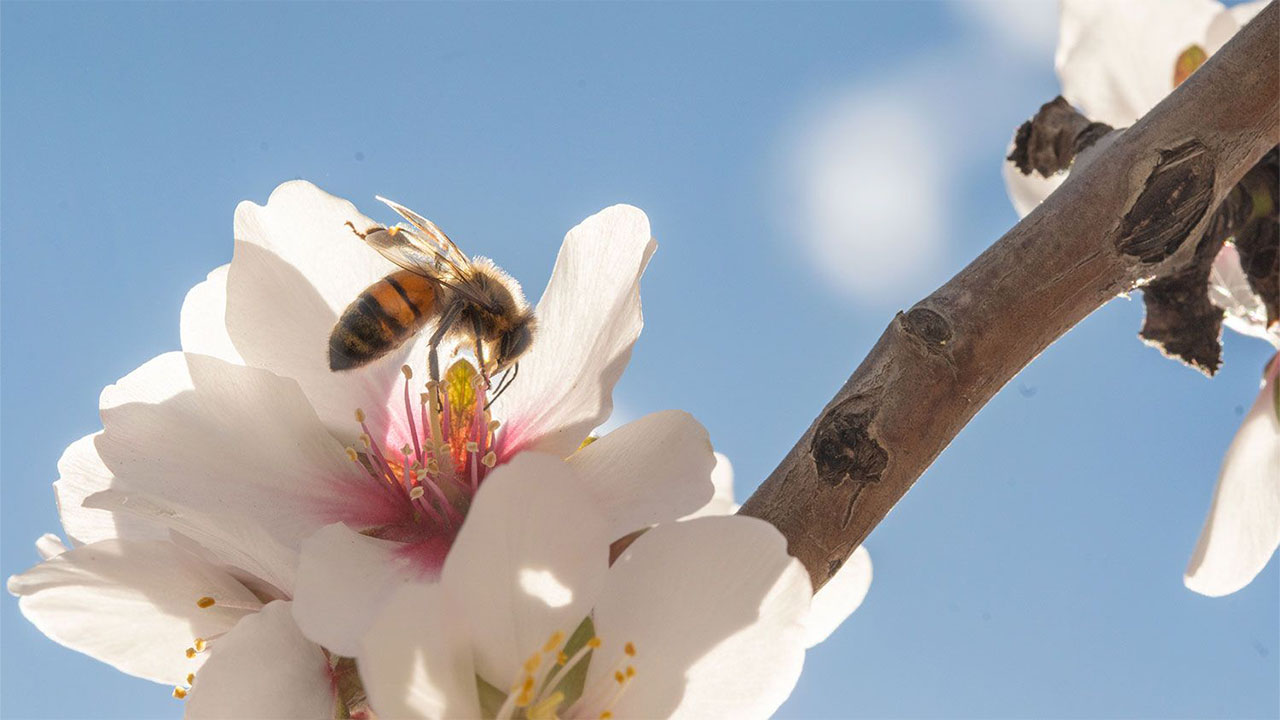Bees come across the country to pollinate the 1-million-acre Central Valley almond crop. But this spring, beekeepers opened their hives to find unprecedented levels of loss. (BeeHero)

- Beekeepers report beehive deaths at levels not seen since 2006.
- Up to 1.1 million hives may have failed, leaving a 500,000-colony shortfall for the 2025 pollination season, BeeHero CEO Omer Davidi said.
- Beekeepers have to deal with growing environmental problems, but the varroa mite can be especially devastating for colonies.
Share
|
Getting your Trinity Audio player ready...
|
When beekeepers opened their hives for the first time this year, many of them found devastating numbers of empty hives.
Even good beekeepers saw mortality rates they’ve never seen before, said Omer Davidi, CEO and co-founder of BeeHero, a hive monitoring company.
“There’s a big crisis out there,” Davidi told GV Wire. “We are seeing some commercial beekeepers reporting roughly 70% of their bee colonies literally dead.”
Colony collapse disorder has plagued the honeybee industry for more than 15 years. But the mortality rate reported this year reached levels not seen since 2006, the U.S. Department of Agriculture reports.
As many as 1.1 million hives may collapsed, leaving a nationwide shortfall of 500,000 hives for the 2025 pollination season. One survey from Project Apis m. shows 60% loss of colonies, according to the USDA. Early survey results showed commercial beekeeping operations suffering more than hobbyists or small-scale operators.
The board chair of Project Apis m. told BeeCulture.com that these losses are unsustainable for the nation’s food supply.
In response to what it calls a potential threat to food production and supply, the department has set up laboratories to research the high mortality rate. BeeHero has also begun collecting data for the USDA, Davidi said. BeeHero’s monitoring technology provides a hive-level look at several metrics to enhance pollination.
Only a few weeks into the season, it’s not known if the problem is a virus, parasite, or climate event. But for a species so integral to the world’s food supply, Davidi says the industry needs better monitoring.
Related Story: New Self-Pollinating Almond Tree Could Be Huge for a Big Fresno Cash Crop
“With no pollination, you have no food production, period, and we have almost zero visibility into what’s happening,” Davidi said. “The fact that we wake up one day and realize that we have half a million hives short for the pollination needs of the country, I think that’s a big concern. That’s where I think we need to revisit how we do things.”
Mortality Has Researchers Stumped
Colony collapse disorder is a generic term for when worker bees abandon their hives. They’ll leave behind the brood, food, honey, and even the queen. Oftentimes, no dead bees will be found around the hive. Researchers generally agree it’s a confluence of factors that leads to the phenomena.
Beekeepers will expect to find about 15% of their colonies dead after hibernation, Davidi said. In the years since colony collapse, that rate has grown to about 40%, but it’s since stabilized.
This year, however, even good beekeepers saw alarming rates, Davidi said. Those high mortality rates seem to be pretty universal, leading Davidi to think the problem could be environmental.
“There are very good beekeepers out there that experienced mortality rates they have never seen, I tend to think there’s something in the environment that caused it,” Davidi said. “It will probably take a few more months to put the finger on it.”
Just as mortality rates jumped significantly in the past before stabilizing, it’s possible this level of die-off could become the norm, Davidi said.
But even if the die-off phenomenon turns out to be limited to this year, it will take two to three years for beekeepers to recover from this year’s losses, he said.

Varroa Mite the Biggest Threat to Commercial Hives: Ballis
The varroa mite is perhaps the biggest threat facing commercial beehives.
Beekeeper John Ballis lost about 70% of his hives this past season, he said. He’s seen firsthand the effect the parasite has on a bee colony.
The mite gets into the hive cells when bees are just larva. When the larva mature, the mite goes with them, bringing disease to the colony and spreading. The parasite can cause crippled wing disease or others, Ballis said.
Bees are hygienic so they’ll take infected larva out of the hive. In certain cases, bees will leave the hive entirely. And, without the bees there to keep the brood warm, they’ll all die off.
Bees from other colonies will then sometimes go to abandoned hives to strip them of their resources. There, they too will pick up the mites and continue the cycle.

Unfortunately, the varroa mite has built up resistances to treatments.
“They have to use harsher and harsher chemicals to kill the same bug that years ago they were killing pretty easy,” Ballis said.
The growing ineffectiveness of treatments against the varroa mite could be a contributing factor to high mortality rates.
Monitoring Helps Sustain Beehives: Davidi
When the industry first saw the 40% mortality rates arise, scientists identified several stressors, Davidi said. While Bees face biological threats such as the varroa mite, chemical and pesticide exposure have also contributed greatly to poor colony health. Colder, dryer winters also mean less food for bees.
In addition, shrinking natural habitats and farming monoculture changed the way beehives have to be managed.
To pollinate crops in time for the season, some beekeepers have to push their hives at times workers shouldn’t leave the hive, Ballis said. He’s seen strange bee behavior in the past few years. He’ll get calls about swarming in the fall instead of in the spring.
Keeping bees alive to pollinate may require greater monitoring when they would otherwise be left alone, Davidi said.
Davidi said he’s seen monitoring during hibernation periods keep colonies from dying off. One grower found that hives in a particularly cold year had gone through their winter food reserves much faster than anticipated, Davidi said. By adding more food, he kept the hive alive.
“It’s not necessarily rocket science in some of the problems, it’s more about knowing what’s happened. The beekeepers can handle most if not all the problems,” Davidi said.
The other solution may be greater global connectedness, Davidi’ said. If a beekeeper anticipates a shortage in October or November, colonies from the southern hemisphere could be imported to sustain local populations.
However, bees from other countries can bring in other parasites such as tropilaelaps — a mite not yet found in the U.S., according to Project Apis m.
“It’s not a trivial thing to do, but if you have to choose between biosecurity and food security, that’s where you need to at least be able to make those decisions,” Davidi said.



















